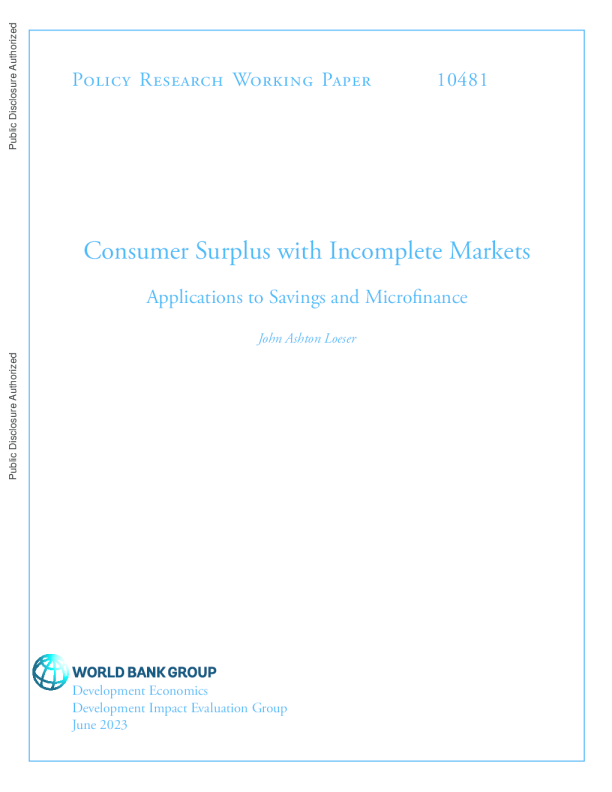不完全市场下的消费者剩余:在储蓄和小额信贷中的应用(英)
 AI智能总结
AI智能总结
政策研究工作报告 10481 公共公披共公露披共公授露披共权授露披权授 消费者在不完善市场中的剩余价值 申请储蓄和小额信贷 约翰阿什顿洛泽尔 发展经济学发展影响评估组2023年6月 政策研究工作论文10481 摘要 家庭从金融包容性中获得的好处难以从实证上捕捉 。本文确立,家庭从金融技术中获得的好处等于在具有不完整金融市场、一般技术和偏好以及选择集的家庭模型中,动态补偿需求下的面积。然后本文继续 估计补偿了金融技术利用三个随机对照试验引入的利率实验变异性对需求的影响。每贷出或节省一美元所带来的福利收益较小,因为补偿的需求弹性较大,但仍然对应于金融包容性带来的巨大总体福利收益。 本文是发展影响评估组,发展经济学的成果。它是世界银行为提供其研究的开放式访问并促进全球发展政策讨论而努力的一部分。政策研究报告也发布在httpwwwworldbankorgprwp网站上。作者可以通过jloeserworldbankorg联系。 《政策研究工作论文系列》传播正在进行中的工作的发现,以鼓励关于发展的思想交流。问题。该系列的目标是迅速发布研究结果,即使展示内容尚未完全完善。这些论文带有作者姓名应相应引用。本文中表达的研究发现、解释和结论完全是作者本人的。 作者的观点。它们不一定代表世界银行国际复兴开发银行的观点。其附属机构,或世界银行执行董事或他们所代表的政府。 由研究支持团队制作 消费者剩余在不完整市场中的应用:储蓄与微型金融 约翰洛泽尔 JEL分类代码:D11D14G51O1O12O16 关键词:消费者剩余,不完全金融市场,金融包容性 jloeserworldbankorg。本研究受益于DanielAgness、KatyBergstrom、AlfredoBurlando、KieranByrne、AlaindeJanvry、EmmaFrankham、XavierGine、SeanHiggins、DahyeonJeong、ErinKelley、CynthiaKinnan、FlorenceKondylis、GregLane、AriannaLegovini、JeremyMagruder、AprajitMahajan、DavidMcKenzie、ElisabethSadoulet、HeeKwonSeo、UrsulaWiriadinata、BrianWright以及NEUDC、UCBerkeley、WEFIDEV和世界银行研讨会听众的建议和评论。对CEGAVisa金融包容性实验室的财务支持表示衷心的感谢。所表达的观点不代表世界银行的观点。所有错误均由本人承担。 发展影响评估,世界银行 目录 1引言2 消费者剩余与不完整的金融市场6 21模型7 211环境7 212模型解的存在性9 213模型的图形表示9 22罗伊的身份11 23消费者剩余12 231等价变化12 232马歇尔剩余14 233未补偿和补偿的需求弹性14 24扩展16 3实用指南:金融技术领域的消费者剩余16 31定义、估计和绘制金融技术需求图17 32对动态补偿需求的简化假设18 33扩展内容21 4消费者从储蓄和微型金融中获得的剩余价值23 41退休储蓄(杜弗洛等,2006年)23 411研究背景与实验设计23 412需求弹性与消费者剩余25 42承诺储蓄(KarlanZinman,2018) 421研究背景与实验设计 422需求弹性与消费者剩余 43小额信贷(KarlanZinman,2019) 431研究背景与实验设计 432需求弹性与消费者剩余 27 27 28 30 30 32 44结果讨论 5结论 36 38 1引言 家庭福利从微型金融中获得了哪些收益?每年有超过2亿户家庭从微型金融机构借款。尽管规模如此之大,但越来越多的实证共识认为,微型金融未能实现其原始承诺,反而对借款人产生了积极但适度的影响(。Banerjee等人2015b贫乏的2019然而,估算福利收益是困难的。家庭可能通过广泛的各种机制从微型金融中受益微型金融使得生产性投资和大规模采购成为可能(。Banerjee等人2021消费平滑车道2020并作为传统信贷的入口(RigolRoth2021因此,小额信贷对常见福利指标 (包括家庭消费)的影响及其显著性可能与对福利的影响不一致()Banerjee等人2015b,并需要对这些多样化的机制进行理论解释,以便量化对福利的影响()KarlanZinman2019 在本文中,我提出了一种方法来估计来自金融技术(包括微finance)的居民福利收益,该方法基于以下结果:消费者剩余等于动态补偿需求下的面积。为了捕捉发展中国家家庭消费和投资决策的复杂性,我开发了一个包含不完全金融市场和一般技术、偏好和选择集的动态家庭模型。我表明,动态补偿需求下的面积等于消费者剩余。然后,我利用三个随机对照试验中价格变化的实验性变动来估计补偿需求和消费者剩余,从金融技术中获得了庞大的总体消费者剩余,尽管每美元贷款或储蓄的消费者剩余很小,因为补偿需求弹性较大。 该领域中补偿需求面积作为衡量消费者剩余的金融技术的基本直觉,可通过以下模式化示例来捕捉,如图所示。1考虑一位借款人,该借款人从本金1000美元的贷款中借款,为此,借款人需要每月支付100美元,共计12个月。借款人的最低“接受意愿”(WTA) 即在保持固定月付款的前提下,借款人愿意接受的最低本金,此时借款人会接受贷款 。贷款的借款人盈余是本金1000美元(即“价格”)与其WTA之间的差额尽管当提供的本金低于借款人的WTA时,借款人隐性地改变其行为,拒绝贷款,但信封定理仍然成立,这些反应对福利没有一阶影响。在标准的消费者理论中,在保持产品属性不变的情况下,商品的需求作为价格的一个函数,描绘出支付意愿;对于贷款而言,每月付款作为提供的本金的一个函数,描绘出WTA。这是 颠覆了传统对贷款的观点:不是将借款量视为利率的函数,这并不能给出自然的花费度量,而是将每月还款需求描述为“价格”的函数,负贷款金额作为自然的花费度量。因此,贷款需求下的面积等于总借款者剩余,即提供的本金与WTA之间的差异。 图1:贷款需求和借款收益的示例 我:我认为在具有不完全金融市场的一般动态家庭模型中估计消费者剩余是一个问题。由于金融市场不完整,家庭可能无法在不同状态下转移收入,因此“永久收入”定义不明确 。因此,对价格变化的补偿转移是动态的根据罗伊恒等式,对于任何小的价格变化 ,价格变化乘以时期状态相关数量就是补偿转移()。Farhi等人2022将补偿性转移在价格变化中进行整合表明,在动态补偿需求下的时段状态条件下的面积等于消费者剩余。 我证明了在弱技术假设下,周期状态条件下的动态补偿需求下的面积实际上等于在偏好 、技术和选择集上的消费者剩余。这种灵活性对于捕捉发展中国家家庭金融的重要方面至关重要家庭在消费和投资方面可能存在非凸性(。Banerjee等人2021可能会在作出战略违约决策时面临动态的、可能非货币性的偿还激励措施()Feigenbergetal2013并可能对事前和事后获得金融技术做出反应()车道2020我通过假 设家庭是理性的,并应用包络定理来允许这种灵活性(。米尔格罗姆与塞格尔2002通过假设价格变化仅通过家庭动态预算约束进入家庭问题。 估计动态补偿需求需要估算价格弹性和收入效应;与静态家庭模型相反,而不是单一的 收入效应,需求对收入的时间序列影响的全矩阵是必要的。我采用足够统计方法(切蒂2 009)并展示这个跨时期收入效应矩阵是两个术语的内积临时收入的边际消费倾向矩阵和需求增长。对这个矩阵的约束产生两个常见框架:在完全金融市场下,边际消费倾向的跨时期矩阵是秩1,而在没有金融市场和可分离效用(即静态家庭模型)的情况下 ,它是对角线。在应用中,我使用需求增长的实证估计,并提出关于跨时期边际消费倾向的理论动机界限。 在我的模型框架中嵌入了一些强烈的假设。与许多用于分析金融技术影响的分析框架类似,我假设家庭对技术有全面的信息,并且不会出现行为偏差。为了关注家庭福利,我不考虑一般均衡效应或生产者剩余。然而,通过将金融技术引起的消费者剩余的估算降低到需求的估算,我为基于静态模型中需求的广泛模型和方法的应用提供了理论依据。 我随后从三个随机对照试验中估计了金融技术的消费者剩余(杜弗奥等人2006KarlanZinman20182019每个实验都在价格上引入了变化:分别是对退休储蓄账户的存款、对承诺储蓄账户的存款和小额信贷贷款。正如在典型示例中,实验处理要么在期末余额条件下减少了储蓄者的存款,要么在还款计划条件下增加了借款者的贷款金额 ;进而,这增加了存款和贷款金额。然后,我在三个实验中估计了存款和贷款金额的价格弹性,范围从4至14;这些只是对每篇论文估计影响量的适当缩放。然后,我构建了补偿价格弹性的界限:一般来说,这些界限比统计不确定性窄。在这三个实验中,补偿价格弹性的存款和贷款金额对应于每年每100美元存款或贷款金额的7至27美元的消费剩余 。 我总结性地讨论了对我消费者剩余估计的解释。我将我的估计与现有关于储蓄和信贷技术对家庭消费影响的实验和准实验研究进行比较,家庭消费常作为福利的代理指标;标准误差相对于我的估计值较大,这表明这些研究在事后检测到等于我消费者剩余估计的影响时,力量不足。 尽管如此,我的估计表明,当通过低收入国家家庭信贷和储蓄的采用来扩大规模时,金融技术将带来巨大的福利收益。 相关文献本文采用充分统计方法估算金融技术带来的家庭福利收益,补充了采用简化形式和结构方法进行的估算。越来越多的文献应用实验和准实验方法来估算获得小额信贷对家庭的影响(例如,)。皮特和汗德克尔1998KarlanZinman2011KaboskiTownsend2012Banerjee等人 2015b贫乏的2019车道2020此研究确定了借款的消费平滑化、耐用消费品消费和投资动机,并发现家庭福利代理指标影响多数为积极但并不精确。然而,理论对于量化家庭福利是必要的:金融技术对常见福利指标(如家庭消费)的影响,无需与福利本身的影响相一致,例如当借款与大规模投资互补时(Banerjee等人2015bKaboskiTownsend2011在微观金融借款的结构模型中,我估计了家庭福利,该模型允许消费平滑、生产性投资以及对微观金融的战略性违约;我展示了我从微观金融中得出的消费者剩余的点估计与他们的相当。虽然简化形式和结构方法揭示了微观金融对借款者影响的潜在机制并进行量化,但我所采用的充分统计方法通过使消费者剩余在一般新古典家庭模型下得以估计,补充了这些方法。 为了估算微型金融带来的家庭福利增长,本文将消费者剩余的计算方法扩展到不完全金融市场模型中。在这方面,它最接近于Farhi等人2022提供了从不完全金融市场中的小价格变动推导消费者剩余的公式,并且在此基础上生产了一个更全面的价格理论;相比之下,我仅关注消费者剩余,因此能够得出关于大价格变动、更一般化偏好、非线性技术和内生选择集的结果。我直接基于静态模型中精确消费者剩余的研究成果(威利斯1976Hausman1981特别是,我将确切消费者剩余表示为微分方程的解。与静态模型相比,存在多个不同的解;对于给定的价格变化路径,我选择不需要对边际效用进行估计的解。我还补充了现有方法,这些方法在完全参数化的结构模型和有缺陷的金融市场下估计消费者剩余。KaboskiTownsend2011估计等效变化为改善信贷可获取性作为初始期转移。Lagakosetal2018估计季节性移民的动态补偿消费转移。我通过提出足够的 统计不完全金融市场中的等价转移;这些足够的统计数据可以从价格和收入的实验性变化中估计得出。 这些结果有助于分析具有不完整金融市场的动态家庭模型中的福利增益分析。我表明,动态补偿的需求弹性直接反映了从一般的时间替代技术(包括金融技术)中获得的福利增益。对于那些在金融技术价格方面隔离实验或准实验变差的学术研究()。杜弗奥等人2006KarlanZinman2008 2




